
A Report on a Visit to the Shellfish-divers of Katada
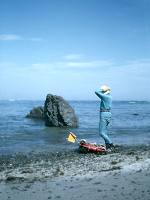
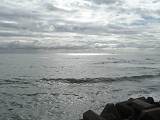
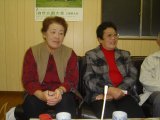
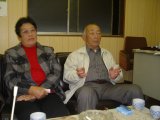

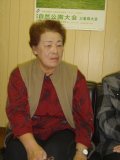
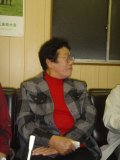
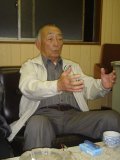
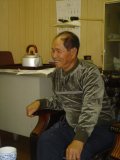
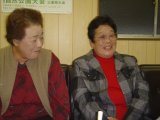
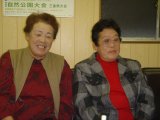
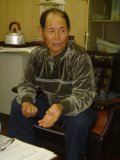



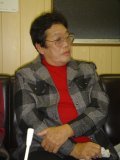
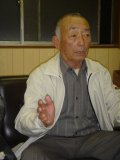
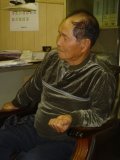
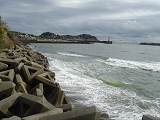
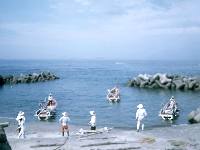
This I wrote after having observed several summer-weeks in 1983 the life of the shellfish-divers of the fishing village of Katada in Mie-prefecture in central Japan. When I paid a short visit to Katada in November 2006, my first impression was that surprisingly little had changed. Mr. Ôta, the former chairman of the fisheries cooperative, two ama-divers and a boat-man told me about their sorrows because of the lack of young divers, the environmental pollution and the dramatic decline of fishing rates. But still the ama go out into the sea, fishing abalone in their little boats or with their floating tires and "perpetuate today the use of fishing methods used by their ancestors in ancient times" (Bouchy 1999, 352).
Anthropologists about Japanese ama
At that time, in 1983, I planned a "detailed documentation about
the women-divers of the fishing village Katada"
2).
I could not carry out this plan, but in the meantime some anthropologists
produced extensive and excellent monographs or papers in English about
ama-divers of the same region. Above all one has to mention the
depiction of the ama-divers of Kuzaki in their social and religious
context, which
D.P.
Martinez published in her book "Identity and Ritual in a Japanese Diving
Village - The Making and Becoming of Person and Place." She spent 14 months
from 1984 to 1985 in the fishing village, which, as the legend tells, delivers
dried awabi to the holiest shintoist sanctuary of Japan, the Ise shrine, since
2000 years ago.
Soon afterwards
Anne
Bouchy conducted research-work in nearby Ijika and reported about this in
her paper "The Chisel of the Women Divers and the Bow of the Feudal Lords of
the Sea: The Dual Structure of Labor and Village Organization in Women
Divers´Society - A Case Study of the Town of Ijika (City of Toba, Mie
Prefecture)", which appeared in 1999.
In the Internet I found the article
"Governed by the limits of their endurance - their courage knows no depths -
Women Divers of Japan" by
Bethany
Leigh Grenald of the University of Michigan, who reports in 1998: "I have
spent the last year-and-a-half living and diving with the ama".
And
David Plath produced in 1993, "based on more than a decade of field research",
together with Jacquetta Hill, the award-winning video-documentation
"Fit
Surroundings", which deals with the life of the women-divers in Fuseda, a
neighbouring village to Katada. A very informative study guide is enclosed.
This as well as the documentations of
Martinez
and
Bouchy
refer to numerous further publications which offer a deepened coverage of the
topic.
Visit to Katada after 23 years
I myself used my stay in Japan in 2006, the main purpose of which
was to continue the research for the biography of Imai
Yasuko, to make a short trip to Katada. There I had met the last time
Ôta Kazuo, the chairman of the fisheries cooperative and
Yamamoto Tamae, the
landlady of the guesthouse Mugizaki-sô, at the time of the
Bon-Festival 1985. When I prepared my journey to Japan in 2006, I wrote to both
persons and had to learn from Mr. Ôta, that Yamamoto Tamae had died about
ten years ago, that her daughter in law Atsuko, with whom I had become friends,
had moved with her family to some big town, and that the
Mugizaki-sô, as well as the three other guest houses of Katada had
closed down "because of lack of guests".
Mr. Ôta´s wife had
died two years ago at the beach on her way to her diving work, and
Ôtawa Tamako, who had
been the representative of the women´s section of the fisheries
cooperative and had introduced me to the profession of the women-divers at my
first visit to Katada in 1978, also died long ago.
But Mr. Ôta, a
gentleman of 78 years, is very agile. From 1980 to 2002 he was chairman, now he
is still active as a member of the executive board of the fisheries
cooperative. He arranges for me and my companion to stay in a ryokan
with excellent cuisine in the neighbouring village of Wagu and welcomes us on a
rainy november-evening in his widowed household.
From mid-September to
mid-March there is no diving and therefore I can only find out possible changes
since 1983 by talking. Two women divers of Katada agree to an interview. They
arrive the next morning by moped in the office of the fisheries cooperative.
Diving like in 1983
Takeuchi Tomiko, 66, and Takahashi Kazue, 68, are both broad
shouldered vigorous women with short dyed hair and sparkling eyes. While giving
their interviews they laugh a lot. Both were representatives of the
women´s section of the fisheries cooperative in former years. They are
accompanied by Mr. Hamaguchi Kyoshi, 79, sendô or boat man. He is
the partner in life and work of Mrs. Takahashi and goes out into the sea with
her in an ipponbiki-boat. Mr. Hamaguchi and his late wife were a
legendary good diving-team, but also he and his present companion harmonize
very successfully as their colleague, Mrs. Takeuchi, reports.
I ask the
ama, if they have been diving already 23 years ago, when I did my
research in Katada.
"That I startedama-work (keiko shita) ,
fifty years have gone by", laughs Mrs. Takahashi. Professionally she dives
since she was nineteen. But already as a child she made "mizuasobi"
(played in the water). Her mother and grandmother where divers too. Mr.
Takeuchi stresses, that she is not as good, because she practized only after
having been married and having born a child. "Now I am doing ama-work
for thirty years and I am a veteran, but now there are hardly any abalone
left."
Like 23 years ago the divers of Katada go out by boat and
accompanied by a boatman or they swim from the shores with diving floats. Also
the terms for this, ipponbiki, haikara, okedo and
kachido, are still used3).
Still the boat-ama descent to the depths of the sea secured by a
lifeline (iki-tsuna) and with an iron rod (fundo) as
counterweight. Down there they pull the shellfish of the underwater-reefs with
the help of a chisel (nomi).
The couple confers, how deep Mrs.
Takahashi is able to dive these days. They agree on eight hiro.
Hiro is a maritime depth gauge, about 1.80 meters. Mrs. Takeuchi, who
forms a diving team with her husband and her daughter in law, says about her
colleagues: "These both are really great. I only dive half that depth. But I
have started late and besides, for some years now I only dive on more shallow
spots, which I can still manage with my breath."
Like the ama have
done for more than 1000 years, since the women-divers´ profession exists
in Japan, also the ama of Katada of today breath only with the power of
their own lungs (jibun no iki de) and can therefore stay under water
only for one or two minutes at most. To use artificial oxygen, that is to dive
with an air tank, is in 2006 equally forbidden as in 1983, explains Mr.
Ôta. "With oxygen one could stay under water much longer and this would
soon destroy the resource base."
Also Dr. Matsuda Hirokazu of the Fisheries
Research Division of the Mie Prefectural Science and Technology Promotion
Center confirms that the women-divers will go on working without air tanks.
"Otherwise the sea would be overfished at once."
4)
The fisheries cooperative decides
"Another problem is that the organization responsible for deciding
all rules and regulations concerning the ama´s diving is the exclusively
male fishing industry cooperative", Anne Bouchy observed in Ijika
(Bouchy,
369). "It was not only wet suits, but all aspects of diving that the
Kumi-ai regulated: deciding the beginning and the end of diving seasons;
whether the weather and sea were safe for diving; and from which beaches the
divers should work," D.P. Martinez noticed in Kuzaki
(Martinez,
110). And in Katada it is the same. Also Mrs. Takahashi and Mrs. Takeuchi
drop often the word "kyôka" (permission). It is the local
fisheries cooperative (gyogyô-kyôdô-kumiai) which
decides. Among other things it determined - but after discussing the matter
with the ama-san, as they emphasize - that since the seventies the
divers wear the so-called wet suits, which protects against cold and injuries.
A time limit was installed then to prevent overfishing. "With the wet suits one
could dive for a longer period or several times a day although if is cold", Mr.
Ôta says.
In former days a time limit was not necessary, because
attired in thin isogi or amagi, that white cotton dress, which
the women-divers wear still for tourists, the coldness of the water regulated
the working time. But in Katada it is not like in Kuzaki, where D.P. Martinez
learned that only one wet suit per household is allowed
(Martinez,
109). For example in Mrs. Takeuchi´s household she and the
o-yome-san (daughter in law) own wet suits.
There were wet suits at
the beginning of the eighties, when I was in Katada, and also there was the
diving season from March to September, the daily going out into the sea in the
morning and in the afternoon and the diving time of one hour each in spring and
one hour and a half in summer. The amakoya or ama-huts, where the
women rest after diving, warm themselves up and prepare the next dive, offered
and offer them a space of relaxation and freedom from their obligations as
family-women. However in 1983 I was told, that the ama-huts as well as
the boats belong to the boatmen. Now Mrs. Takeuchi holds: "They belong to the
ama san and their friends." Comparing with 23 years ago, they are much
more beautiful now, I am told, often made of concrete, real houses, with
refrigerators and stoves.
So at last I arrive at the changes of the last
two decades.
Women´s section disbanded
In 1983 as well as today all divers must be members of the
fisheries cooperative. The admission fee for an ama is 100 000 Yen at the
moment , that means about 640 Euro
5).
A change took place in the organizational structure: The local fishing
cooperatives have been merged recently. Today one speaks about the "National
fisheries cooperative of Shima, Katada branch (Shima no
kunigyogyôkyôdôkumiai Katada shisho)".
6)
In
the course of this centralization the women´s section was abolished.
Takahashi san and Takeuchi san, both former representatives, express their
disapproval clearly. One of their tasks had been the saving of money, but when
centralizing the local fisheries cooperatives the financial transactions had
been outsourced. Apart from financial matters the women´s section had
been engaged the last decades in the struggle against environmental pollution.
"The women´s section was always cooperative, but this was not
acknowledged at all," Mrs. Takeuchi says.
The fact that the women´s
section was abandoned by the fisheries cooperative confirms the observations
made by Bouchy and
Martinez
in other fishing communities. As Bouchy writes in her article: "...women are
excluded from positions of authority and speaking roles"
(Bouchy,
366). The women divers have no command of externally visible positions of
power. In Katada besides of the fisheries cooperative there also exist
cooperatives for agriculture and pearl breeding, but no managerial functions
are occupied by women, and Mr. Ôta does not know any example outside of
Katada either.
With the dissolving of the women´s section in Katada a
formal position of influence for women was lost, which I see as a step in the
direction that is depicted in the literature about the ama-profession:
Since the Meiji-period the women divers seem to lose bit by bit their
remarkable position in the household and in the fisheries communities.
Male divers and diving machines
In 1983 the fisheries cooperative of Katada represented about 120
women divers
7).
There were 40 diving boats and the same number of boat men, but no men, who
were diving. Today my interview-partners agree, that there are about 100 divers
and 30 boats. "90 percent of the diving persons are women and ten percent are
men." Ama is traditional a women´s profession, but since old times
there have also been men, who were diving, Mr. Ôta says. In 1983 there
worked no male divers in Katada, but now some younger men go out alone by boat
and dive for abalone. This has also to do with the lack of ama in the younger
generation.
Up to the generation of my interview-partners the daughters of
ama became ama. But neither Mr. Ôta´s daughter or
grand daughter nor the daughter of Mrs. Takahashi or the daughter of Mrs.
Takeuchi have become divers.
"For a long time the question of succession of
the divers has been a topic at the general assemblies of the cooperative," Mr.
Ôta points out. Also the fishermen know this problem. Young people want
to do a safe and dry work. "Young people of today amuse themselves at the
seaside (kaisuiyoku) or go swimming (suiei). My daughter and my
younger sister said that they are afraid when the sea around them gets black".
All four interview partners burst out laughing.
"If this trend is
continuing in the future for years or decades, if the products are here but no
people to get them out of the sea, one will use diving machines which the
cooperative provides", Mr. Ôta hints.
The words "sensuiki"
(diving machine) and "sensuigu" (diving tool) I hear for the first time
in this context. Mr. Hamaguchi drops the word "aqua lung". And Mr. Ôta
explains, that, in case the ama grow too old for diving and there are no
successors, the cooperative of Katada will engage divers from the outside, who
with the help of underwater breathing instruments shall catch a locally or
numerically predefined amount of grown up abalone, which then belong to the
cooperative. In such a system the ama would be completely excluded.
The two
attending divers don´t seem to think much of this idea. Mr. Ôta and
Mr. Hamaguchi hold, the cooperative had to insure, that the abalone could be
collected at the right moment, if not, the quality and the price would
decrease. "We will catch the abalone for certain, if there are any!" both women
exclaim.
Dr. Matsuda of the Fisheries Research Division confirms: "At
present their are hardly any young women divers in the region. Moreover the
number of divers declines each year. It is possible that this tendency will
continue." He knows that there are male ama 8)
and repeats: "For young people with little experience maybe the techniques of
diving will change a little, but air tanks or other diving instruments they
will not use also in future."
9)
Part time ama
That no young women at all want to dive, this is not quite true,
my interview partners indicate. "My daughter in law is ama. She is now
forty and has trained diving about the age of 33," Mrs. Takeuchi says.
Considering the age of the ama-colleages, both divers resume: " The
youngest ama of Katada ist about 33 or 34 years old." Mrs. Takeuchi:
"Together with her husband she has a pub, where she works at night. She likes
diving and trains with a floating tire (bui). She wants to share the
boat with me and my husband."
It turns out, that for young women after
school diving is no longer an option, but if they get married and have
children, the labor in the sea becomes more attractive. In Katada their are not
too much possibilities for work and the diving season only lasts half a year.
As Mr. Ôta informs me, the best divers of Katada earn in one diving
season from March to September 500 000 to 3 500 000 yen, which corresponds to
3200 to 22 300 euro. Annualized this would be a monthly income of 270 to 1860
euro.
According to Itô Yoshimasa of the municipal office of the city
of Shima, the female divers can earn at present up to 4 000 000 to 6 000 000
yen per season. Almost always this is the case when a couple dives together, so
that it is the income for two persons. 20 or 30 years ago the divers could earn
much more, up to more than 10 000 000 yen (about 63 700 euro). There has been
the saying: "This is no wife of Shima, who cannot nourish one or two men".
Anyway, the work of the ama seems to develop towards an (often very good) additional income. Already at the end of the eighties Anne Bouchy observed in Ijika the trend that "more and more women began to work part-time as ama" (Bouchy, 385).
Fewer and fewer abalone
This development is probably quickened by the dramatic decrease of abalone, to which the divers refer again and again. Since the beginnings of ama work in Shima, the awabi, in English abalone, were main-object of their fishing activities. The fishing of this delicacy has always been an "exclusively female occupation" (Bouchy, 355). Strictly speaking the awabi is a kind of snail, but in Japan one refers to it as shell (kai), in English the umbrella term is "shellfish". It settles on the underwater reefs in the shallow waters near the shore. The awabi is used among others for exquisite sushi-consumption. In 1983 good divers of Katada picked per day up to 30 kg of abalone and other shellfish from the crevices of the underwater reefs. Daily the Katada-divers catch an average of 800 kg, they then told me. "This year the biggest catch was 200 kg", says Mr. Ôta in autumn 2006. "Until May we did not fish anything at all", holds Mrs. Takahashi, and Mrs. Takeuchi resumes: "This was no good awabi-year". The statistic of the cooperative supplies evidence for this. In 1970 (Showa 45) their was an annual catch of 60 125 kg in Katada, in 1983 (Showa 58) 74 158 kg, in 1989 (Heisei 1) still 75 807 kg. From this time on with some ups and downs the catch became smaller, and in 2006 (Heisei 18) only 8085 kg landed at the fish market of Katada. The gains of the cooperative show the same curve, from 94 796 000 yen via 244 455 000 to 389 101 000 yen, and they sank finally in 2006 to 56 866 000 yen. In the neighbouring communities you have the same phenomenon. (The revenues of an other main source of income of Katada, pearl breeding, have likewise declined since 1990. On the other hand the all in all fluctuating gains of the fishing of Ise ebi or Japanese lobster, which is the hibernal counterpart to the awabi fishing in summer, have increased during the very last years. Ise ebi-fishing is a pure mens´ job.)
Fighting environmental pollution
People of Katada blame the environmental pollution for the
decrease of abalone. For twenty years they are struggling against it, my
interview partners emphasize.
"Since Mr. Ôta became chairman of the
fisheries cooperative and when I was chairwomen of the women´s
association on Katada the environmental problems were our main concern", Mrs.
Takeuchi says. Also the agriculture cooperative collaborated. Mr. Ôta:
"About ten years ago we founded the association for measures to eliminate
wastewater (Shimachô no seikatsu haisui shori taisaku renraku
kyoinkai)".
The reasons for the pollution of the waters of the river
and the sea are manifold, waste and rubbish, detergents and oils. "The worst
thing was that we then let flow the wastewater of rice washing (kome no
togishiru) and the rice bran (nuka)) from the houses into the sea".
This did damage above all to the young abalone and the sea weed, which is
nutrition for the abalone and a source of income for the fishing villages.
The sea near the coasts became also to a growing extent polluted by fishing
lure, because more and more tourists were fishing from the abalone reefs, my
interview-partners tell me. The surface of the reefs, in the crevices of which
the abalone cling to the rocks, seem to be covered by something like cement and
can no longer keep grounded the animals.
Not only the pacific coast with
the abalone reefs, also the Ago-bay on the other side of the Shima-Peninsula,
were pearl breeding was at home, was damaged by environmental pollution. Here
above all the akoya-shells, in which the pearls are bred, are the reason
for the contamination. People took out the pearls and threw the meat of the
shells back into the water. Everything, which fish do not eat, sinks down to
the sea floor and developes poisonous germs, Mr. Ôta and his colleagues
explain to me.
As a measure against the water pollution Katada people are
using EM-bacteria, so called "Effective Microorganisms ". This method to
decompose deleterious substances and at the same time to produce vitamins,
enzymes and other beneficial agents was invented in Japan. The results are not
scientifically assured, but people of Katada expect a lot from it.
Mr.
Ôta describes how he on one side mixes the EM bacteria in the wastewater
of his household to be able to use it for various purposes, and that on the
other side EM bacterias are added to the water of the Ago-bay. Each month five
tons are to be applied there. On the pacific side of the coast the use of EM is
not possible because of the big waves.
"Each house of Katada has struggled
for 15 or 20 years, and now our river, the ocean and the Ago bay is healthier
again", Mrs. Takeuchi reports. "We all have committed ourselves to the fight
against environmental pollution, so that our sea becomes again a sea, in which
abalone and other animals and sea weed can exist healthily."
Global warming the chief cause?
Dr. Matsuda Hirokazu of the Fisheries Research Division of Mie
Prefecture thinks the effect of EM bacterias limited. "There are no scientific
reports, which connect this measure with the purification of the environment of
the open sea", he writes in an email.
I have contacted the Fisheries
Research Division of the Mie Prefectural Science and Technology Promotion
Center (Mie ken kagakugijutsushinkô-sentâ
suisankenkyûbu), to be able to integrate the phenomenons of Katada in
a greater context.
"There is a tendency of a constant decrease in the catch
of awabi species not only in the Shima region but in the whole Mie prefecture
and in the sea of Southern central Japan," Matsuda Hirokazu writes. He agrees
by and large with the people of Katada, who say, that the water quality of the
sea on the pacific side is "beautiful" (utsukushii). "There are
no scientific results that the water quality of the sea at the coast, which
borders on the open sea, where the awabi live, deteriorates." There is the
possibility of contamination at the mouth of drainpipes and in case of strong
rainfalls there is the possibility, that the ditches for the sewage overflow
and that dirty water reaches the sea, he says. (According to Mr. Ôta
there is no sewage plant in Katada).
Moreover, Dr. Matsuda continues, one
speaks about contamination by environmental hormons, preservative agents and
detergents. There are also reports, that the paint that is used for the floor
of big ships, contains harmful materials. But he personally does not consider
it very probable that these factors are responsible for the decreasing rate of
awabi catches.
Various research establishments are pursuing the
reasons for this phenomenon, and it is thinkable, that several factors like the
overfishing of the parent shells, the warming of the water, which accompanies
the global climate change and the disappearance of the species of sea weed
which are the nutrition for the abalone, that these factors together cause the
decrease of awabi, but at the moment one does not know this for certain, says
Dr. Matsuda.
"What worries me most is the warming up of the water
temperature", he writes. The interrelations are very complicated, the problems
are the temperatures in winter. "During the winter of the last ten years the
average temperature of the water was 1.5 degree higher than the average water
temperature of the decade thirty years ago." (Which means, that in 1983 the
water of the pacific coast at Katada was in winter 1.5 degree lower than
nowadays.) This has a negative effect on arame and kajime, the
sea weed on which the abalone nourish. Additionally each change of temperature
of the Kuroshio, that ocean current, that like the Gulf stream in Europe,
codetermines strongly the Japanese climate, influences the shallow water in
which the awabi live.
Summarizing Dr. Matsuda points out: "In the
present situation one does not know exactly what are the reasons for the
decrease of the abalone. Also the deterioration of the environment, which is
often spoken about, is neither clarified precisely".
Mr. Ôta puts it
less prudent: "Japan does not have enough understanding for the environment.
And because this after all also has influence on the sea, the pollution does
not get well. "
10)
Waterway for cargo ships
At the end of the interview I ask, what big ships I saw this morning passing by very near the seaside of Wagu, the neighbouring village to Katada. "There is a waterway for cargo ships", is the answer. I ask surprised, whether the ships don´t pollute the water. "As the ships now and then emit waste water, there are times, that it gets polluted with oil." And whether the waves, which a big ship produces, do not influence the diving ama or the plants and animals living in the sea? "As the water way is determined exactly and deep, there is no influence on the activity of the ama. " But recently young people who are cruising on the water surface with scooters are becoming numerous and because they do this, also where ama are diving, this is a danger, Mr. Ôta points out.
Later on Mr. Ôta´s daughter shows to me the photo album with the wedding pictures of her daughter while we are eating in a restaurant shrimps, probably imported from South-East Asia. The young women studied at a Shintô university and has made a good marriage to the pontifex of a famous shrine. Afterwards the family accompanies me by car to the coast and instead of a visit to the Mugizaki-sô, from which I observed in 1983 life and work of the ama, I am invited to make a photograph from far away of cape Mugizaki and its lighthouse.
In 1983 Mr. Ôta spoke about a future of five or ten years for the ama´s profession. Actually also in 2007 the small white motorboats with ama and sendô are going out to the Pacific. Perhaps the sea recovers really, as the people of Katada hope, or the sea adapts itself to the worsened conditions and in an other 23 years the ama still will dive for the popular delicacy. But at the moment one cannot be too optimistic. As Mr. Ôta writes, in spring of 2007 the catch of abalone was even smaller than last year.
Notes
1) See Linhart, Ruth, 1983, p. 20
2) See Linhart, Ruth, 1985, p. 87
3) See Linhart, Ruth, 1985, p. 96f
4) The citations of Matsuda Hirokazu, Ph.D., Research Scientist der Fisheries Research Division of the Mie Prefectural Science and Technology Promotion Center are taken from two emails of the 8th and the 15th May 2007, in which Mr. Matsuda answered to my questions.
5) The exchange rate yen to euro is taken from http://www.x-rates.com/calculator.html of August 24th 2007.
6) Itô Yoshimasa of the municipal office of the city of
Shima, the adminstrative unit, to which Katada belongs, answered to questions
about the topic in a letter of June 25th 2007. In his answers he is referring
to all branche-offices of the National fisheries cooperative of Shima.
According to him there are three conditions of admission to the cooperative: 1.
To bring in a capital of 100 000 to 200 000 yen, which are returned when
leaving the cooperative. 2. The diver must dwell in the place where the
cooperative is seated. In case of relocating there is the possibility to remain
a member. 3. The executive board must agree, because the personality of an
applicant is very important, as she has to obey the decisions of the
cooperative.
Furthermore the ama has to pay 5 percent of her daily
income to the cooperative.
7) According to Itô Yoshimasa, with the date of April 4th 2007 Katada had 1072 households with a population of 2759 inhabitants, 1306 men and 1413 women. Itô speaks about a decrease of the population in the region. In 1983 Katada had about 4000 inhabitants and 980 households (siehe Linhart, Ruth, 1985, p.94).
8) The characters for female ama are the ones for "sea" (in Japanese "umi") and "women", (in Japanese "onna"), for male ama the Japanese characters for "sea" and "shi", which means "Samurai" or "gentleman" or "sea" and "human" (hito) (see Martinez, D.P., 2004, p. 31ff).
9) Itô Yoshimasa confirms, that the average ama of Shima is in her mid-sixties and that therefore one has to think about the continuance of the brand product "Shima awabi". In case there will be no successors, there would be no other way than to allow the use of diving apparatus to maintain awabi-fishing. But this is no solution for the near future. In the next years awabi-fishing will probably settle down on a lower level .
10) Itô Yoshimasa of the municipal office of Shima reports, that numerous reefs make the sea in the district of Shima rather dangerous for navigation and that every now and then ships run aground. But in his opinion this fact hardly influences the work of the ama and the plants and animals in the sea. He also heard about the calcification of the sea reefs and about the decrease of the seaweed, which is the nourishment of awabi. Anyway, he does not think, that the pollution of the sea with rice bran or similar things by the inhabitants of the coastal villages plays an important role but that there must be other reasons, which cause the warming and contamination of the sea.
Literature
BOUCHY, ANNE
1999 "The Chisel of the Women Divers and the Bow
of the Feudal Lords of the Sea: The Dual Structure of Labor and Village
Organization in Women Divers´ Society - A Case Study of the Town of Ijika
(City of Toba, Mie Prefecture)", in WAKITA HARUKO, ANNE, BOUCHY and UENO
CHIZUKO (ed.): Gender and Japanese History vol.II. Osaka Univ. Press ,
p.349-390, translated by John Davis.
GRENALD, BETHANY LEIGH
1998 "Governed by the limits of their
endurance - Their courage knows no depths - Women Divers of Japan", Michigan
Today Summer 1998, http://www.umich.edu/~newsinfo/MT/98/Sum98/mt1sm98.html, 8
p.
LINHART, RUTH
1983 "Japan, wie es keiner kennt. Ruth Linhart
war bei den Muscheltaucherinnen von Katada", die frau Heft 37/1983 p. 18 - 20.
1985 "Die Ama von Katada", in LINHART, SEPP (Hg).: Japan -Sprache, Kultur,
Gesellschaft, Festschrift zum 85. Geburtstag von Univ. Prof. Dr. Alexander
Slawik und zum 20-jährigen Bestehen des Instituts für Japanologie der
Universität Wien. Wien, Literas Universitätsverlag, p. 87-107.
1988 "Modern Times for Ama Divers", in: NISH, IAN (Ed.): Contemporary
European Writing on Japan, Scholarly Views from Eastern and Western Europe.
Paul Norbury Publications, Woodchurch Ashford Kent England, p. 114-119.
MARTINEZ, D.P.
2004 Identity and Ritual in a Japanese Diving
Village. The Making and Becoming of Person and Place. University of
Hawai´i Press. Honolulu, 254 p.
PLATH, DAVID and JACQUETTA HILL
1993 Japan: Resources for
Understanding. Fit Surroundings. Video Documentation of the Media Production
Group,University of Illinois at Urbana-Champaign, Asian Educational Media
Service, Center for East Asian Studies and Pacific Studies, 910 South 5th
Street, 230 ISB Champaign, IL 68120, 28 min.
With a Study Guide:
PLATH, DAVID
"Lessons From the Ama" ,
p. 5-22
HAMAGUCHI SAKIKO
Why Don´t You Become a Diver? p. 23-25
Dr. MATSUI TAKESHI, M.D.
The View from a Doctor´s Office, p.
26-29